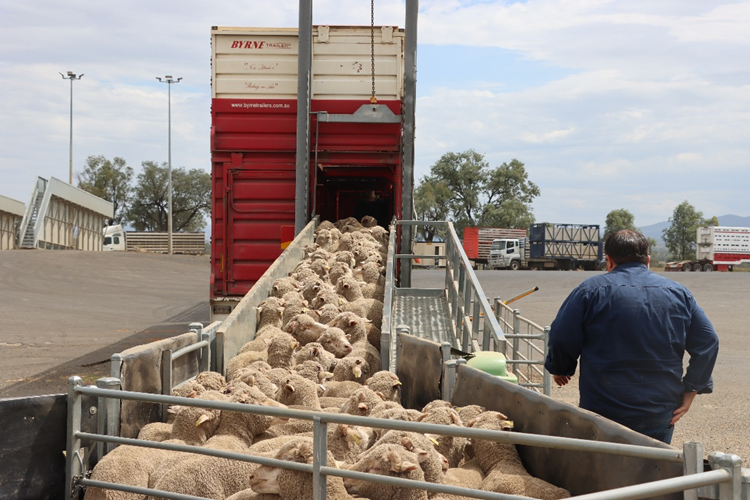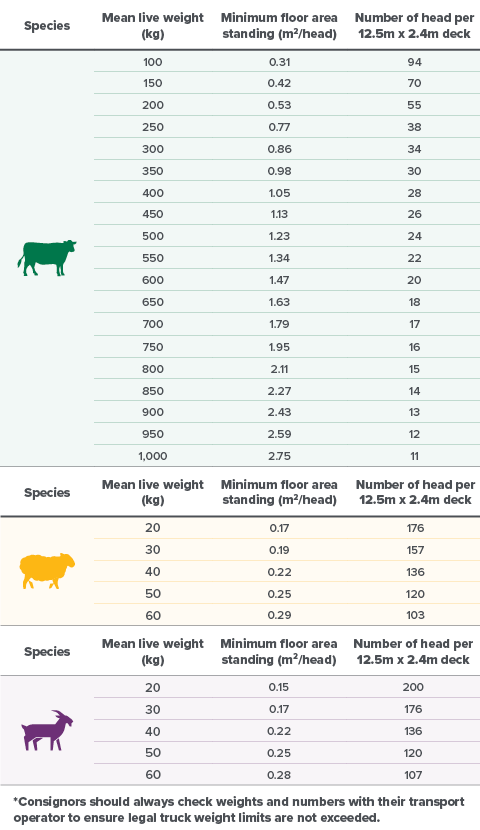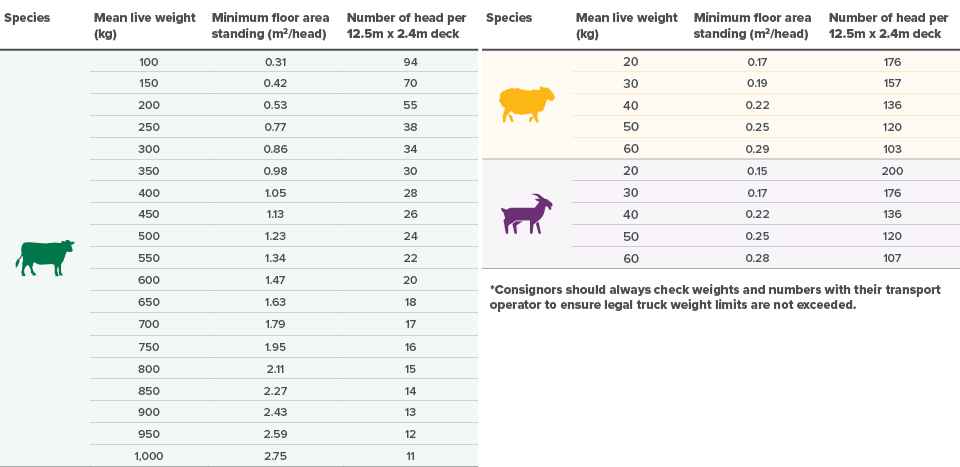Loading livestock for transport

Loading and unloading are the highest risk activities of the transport process.
Tips for successful loading:
- Get animals into the yards well in advance (24 hours) before loading so they can be prepared correctly for their intended journey and are calm.
- Regularly handled livestock load better.
- Be patient with the loading process – don’t rush to a poor outcome.
- Consider safe ramp and yard design.
Safety when loading
Planning for loading is essential for the safety of people and welfare of animals.
- Think about your loading areas before you book livestock transport. If your loading area is not set up correctly it can be unsafe to use certain transport options.
- WorkSafe Victoria has practical, easy-to-read livestock loading and unloading guidelines.
- Safer cattle handling resources from Worksafe Victoria.
Resources
Loading weights and penning densities
The transporter must ensure that the loading of animals into livestock crates adheres to appropriate penning density recommendations to minimize welfare risks.
Producers and agents-communicate accurate types, weights, and numbers of livestock in advance with your transporter.
Loading densities are primarily determined according to body weight but should also consider:
- species and class
- wool or hair length
- weather conditions
- expected transport time
- size and body conditions
- horn status and design
- capacity of the pen/crate


Use of electric prodders
What is industry best practice and what do the animal welfare standards say?
The use of electric prodders on livestock is often controversial and associated with a degree of misunderstanding.
National Standards
There are Australian standards related to the use of electric prodders and these are detailed below with additional links to each of the standards for sheep, cattle and goats and also saleyards. You can read more on the Australian Government’s Animal Welfare Standards and Guidelines webpage. You’ll find references to all livestock species.
Workplace policies on electric prodder usage
Individual producers, transporters, feedlots and meat processors may have their own policies on the use (or otherwise) of electric prodders and these policies should be followed. Producers and feedlots are aware of the negative effects of increased stress on meat quality, particularly meat colour.
Best practice guidelines on electric prodders
Minimise electric prodder usage wherever possible:
- The overwhelming preference is to minimise the use of electric prodders during the livestock transport process, from loading, through the journey and then at the destination.
- Electric prodders are more commonly used for loading livestock than unloading, where they are rarely used.
- They may also be used to stand animals back up if they’ve gone down during transport and can assist in negating an animal welfare risk quite quickly.
- Drivers will often be seen loading cattle with a prodder in their hand, but it shouldn’t be assumed they’re necessarily using it as commonly, they’re not.
Routine prodding is unnecessary:
- Habitual or routine prodding of multiple animals that are moving freely up a race and ramp is completely unnecessary and causes undue stress to the animal – it stirs them up and can make quiet cattle aggressive.
- The same principle applies to prodding animals that have nowhere to go – it’s unnecessary and pointless. Sensible use should be applied and there are other low stress livestock handling techniques that can be used to achieve the same animal movement outcome.
A quick tap can often do the job:
- If cattle are walking easily through the yards and race, up the ramp and through the truck into their pen, there should be no need to use an electric prodder.
- A quick tap on the rear of animals in specific circumstances during loading and penning up on the truck can often avoid risks to human safety and avoid the situation where animals turn around and run back out of the truck, risking their safety and the safety of the driver.
Closing the pen gate:
- The most common situation where prodders can avoid risk to human and animal welfare is when drivers are unable to close a pen gate inside a truck when penning up. An animal partially penned can prevent gate closure.
- Very brief and timely use of a prodder may avoid cattle turning around in a pen gateway, followed by the entire pen exiting the vehicle. This is one of the main risks in penning up cattle inside a stock crate.
- The strong preference is to avoid this situation which can present a significant safety risk to the driver.
Australian Animal Welfare Standards relevant to the use of electric prodders
The standards for the use of electric prodders on sheep, cattle and goats are detailed below. The common theme of the standards across the three species is to minimise the use of prodders, particularly on young animals. Prodders should not be used on the genitals, udders or faces of animals.
Australian Animal Welfare Standards and Guidelines – Land Transport of Livestock
Standard 5. Loading, transporting and unloading livestock
Objective: Livestock are handled, loaded, transported and unloaded in a manner that minimises risks to livestock welfare.
SA5.8: A person who handles livestock in the transport process must not use an electric prodder unless permitted in that species and must not use it:
- on genital, anal or facial areas; or
- on livestock under three months old; or
- on livestock that are unable to move away; or
- excessively on an animal.
Australian Animal Welfare Standards and Guidelines for Cattle
Standard 5. Handling and management
Objective: Handling and management practices are appropriate and minimise the risk to the welfare of cattle.
S5.4
A person must consider the welfare of cattle when using an electric prodder, and must not use it:
- on genital, anal, or udder areas of cattle; or
1b. on facial areas, unless cattle welfare is at risk; or
- on calves less than three months old, unless their welfare is at risk; or
- on cattle that are unable to move away; or
- in an unreasonable manner on cattle.
The Australian Animal Welfare Standards and Guidelines for Sheep
Standard 5. Handling and husbandry
Objective: Handling and husbandry practices are appropriate and minimise the risk to the welfare of sheep.
S5.5
A person must consider the welfare of sheep when using an electric prodder, and must not use it:
- on genital, anal, or udder areas of sheep; or
- on facial areas, unless sheep welfare is at risk; or
- on sheep less than three months old unless sheep welfare is at risk or;
- on sheep that are unable to move away; or
- in an unreasonable manner on sheep.
Australian Industry Welfare Standards and Guidelines for Goats - July 2020
Standard 5. Handling and husbandry
Objective: Handling and husbandry practices are appropriate and minimise the risk to the welfare of sheep.
S5.6
A person must consider the welfare of goats when using an electric prodder, and must not use it:
- on genital, anal, or udder areas of goats; or
- on facial areas, unless goat welfare is at risk; or
- on goats less than three months old unless goat welfare is at risk or;
- on goats that are unable to move away; or
- on visibly pregnant goats; or
- on visibly weak, injured or sick goats; or
- in an unreasonable manner on goats.
The Australian Animal Welfare Standards and Guidelines for Livestock at Saleyards and Depots
Saleyard Welfare Standards
Standard 4. Handling and husbandry
Objective: Handling and husbandry practices are appropriate and minimise the risk to the welfare of livestock.
S4.6
A person must not use an electric prodder in a saleyard or depot:
- on the genital, anal, udder or facial areas of an animal; or
- on livestock under three months old; or
- on livestock that are unable to move away; or
- excessively on an animal.
Note: The State and Territory governments are responsible for the regulation of animal welfare in Australia. Each State and Territory has an Animal Welfare Act outlining their animal welfare legislation.


